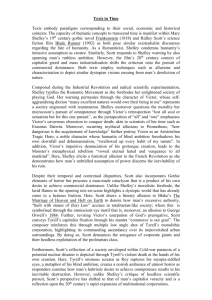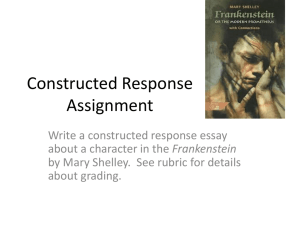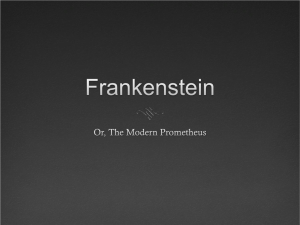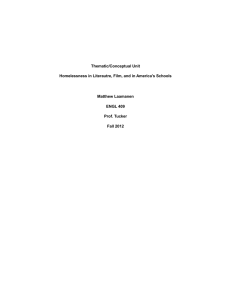Module A – Texts in Time
advertisement
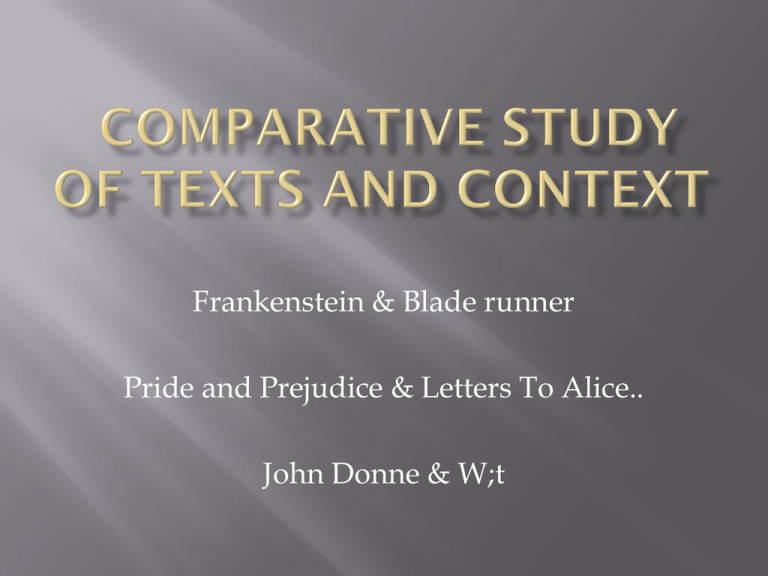
Frankenstein & Blade runner Pride and Prejudice & Letters To Alice.. John Donne & W;t In this elective students will explore how meanings of a pair of texts can be shaped and reshaped by considering the nature of the connections between them. Exploration of the connections between the texts will enhance understanding of the values and contexts of each text. Relationships between these texts may be implicit or explicit. Connections may be established through direct or indirect references, contexts, values, ideas and the use of language forms and features. In this elective students compare how the treatment of similar content in a pair of texts composed in different times and contexts may reflect changing values and perspectives. By considering the texts in their contexts and comparing values, ideas and language forms and features, students come to a heightened understanding of the meaning and significance of each text. In your answer you will be assessed on how well you: Demonstrate understanding of the meanings of a pair of texts when considered together Evaluate the relationships between texts and contexts Organise, develop and express ideas using language appropriate to audience, purpose and form “These responses embedded an evaluation of the relationship between text and context in the analysis of the texts” “incorporated an analysis of the ways in which a comparative study invited deeper understanding of the concepts suggested by the question” “clear understanding of how context influenced the values and ideas in both texts” ‘A deeper understanding of disruption and identity emerges from considering the parallels between Frankenstein and Bladerunner’ Compare how these texts explore disruption and identity ‘A deeper understanding of relationships and identity emerges from pursuing connections between Pride and Prejudice and Letters To Alice on First Reading Jane Austen’ Compare how these texts explore relationships and identity. ‘A deeper understanding of suffering and identity emerges from pursuing the connections between Donne’s poetry and W;t. Compare how these texts explore suffering and identity 1. 2. 3. It doesn’t matter which elective you are doing as both are essentially requiring the same points. They are: Values of each composer Context of each composer- in other words, why did he/she create the text How does the composer present his/her values which have been a result of the context Introduction- that specifically shows how you will ANSWER this question Paragraph 1- Value 1, why (context) and how of your first text, usually the first chronologically Paragraph 2- value 1, why and how of your second text. Link the 2 texts through the change in context which usually causes a change in value Paragraph 3- value 2, why and how of your first text Paragraph 4- value 2, why and how of your second text Conclusion Introduction Paragraph 1- value 1, context and how but in a more integrated manner with discussion from both of your texts Paragraph 2- value 2……. Paragraph 3- value 3 Conclusion This is a much more sophisticated manner of approaching the question but needs practice and thorough understanding of the 2 texts. Analyse how Frankenstein and Bladerunner imaginatively portray individuals who challenge the established values of their time. Analyse how the central values portrayed in Pride and Prejudice are creatively reshaped in Letters To Alice on First Reading Jane Austen. Analyse how the central values portrayed in Donne’s poetry are creatively reshaped in W;t Mary Shelley’s novel Frankenstein and Ridley Scott’s Bladerunner both serve as thoughtful reflections of their own context through their portrayal of individuals who challenge the traditional values of their times and those who attempt to uphold them. Both composers have provided their societies with a warning about the dangerous direction of mankind in light of developments in science and technology that were compromising the values and morals that Scott and Shelley believed to be of great importance Mary Shelley’s seminal novel Frankenstein and Ridley Scott’s cult classic film “Bladerunner” express the contextual concerns of the post industrial and post modern eras respectively. Shelley’s novel operates as a Gothic expression of the conflicting paradigms of Romantic idealism and Enlightenment rationalism. Scott’s film functions as a response to a post modern period predicted upon the dislocation of boundaries in which logocentric truths are fractured and blurred. Both composers, however, imaginatively portray individuals who challenge the established values of their time, doing so with respect to the values and attitudes of their own idiosyncratic contexts Reacting to the period of the Enlightenment in which the belief had developed that science would provide logical reasoning for any question, Shelley has constructed a central character whom embodies the characteristics of the arrogant and ambitious scientist. With developments in galvinism and medicine occurring in the late eighteenth century, Victor Frankenstein reflects the growing trend of scientists who intended on permeating the accepted boundaries of human limitation in the name of science. Shelley regarded the faith in science as a dangerous progression from the previous dependence on nature and religion, and thus Victor’s moral and physical decline is reflective of the composer’s concerns of her time. The highly ambitious and excited language of Chapter 4 can be contrasted with the disappointment and disgust characterising Chapter 5 to reveal the decline of the individual immediately after the creation of the monster, “ a new species will bless me as its creator and source” quickly becomes “with an anxiety that almost amounted to agony” as Shelley indicates the physical and emotional price paid by the individual hoping to challenge what she believed as the traditional values of religion. Ridley Scott similarly warns twentieth century America about the dangers of technological progression and commercialism through his portrayal of a morally corrupt mankind. Tyrell, the owner and creator of the replicants exemplified the traits of the American government, as capitalism was promoted and expanded at the cost of the lower class and the environment. The ecological decay and the Hades-like atmosphere surrounding the Tyrell “pyramid” provide examples of the consequences of the government’s decision to leave pollution output unregulated. With money and prosperity as the primary focus of the Tyrell Corporation, he is conveyed as god-like and also myopic through opulent clothing, a temple-like home and a strong eye motif Scott sustains throughout the film. In neglecting the environment and natural surroundings, Scott perceives Tyrell as the embodiment of the government and the upper class who choose to go against the belief in the importance and value of the natural environment Shelley’s personal context is also explored through her epistolary novel in the characterisation of Frankenstein’s monster. Losing her mother during childbirth and confronting her father’s decision to remarry and ultimately abandon her, Shelley explores the consequential search for identity that she must undertake as a result of his decision to discard the family values that promote love and affection to all mankind. This personal context is clearly reflected through the monster’s endeavours to find a place in society after being isolated by his creator. Shelley incorporated intertextuality in the reading of Paradise Lost in order to challenge the responder to consider who and what is deserving of the love and compassion that is witnessed in the De Lacey family and expected from her own father. ‘I, like Adam, was apparently limited by no link to any other being in existence’. In identifying with Adam, in having the ability to think, feel and empathise, Shelley is not only challenging her audience to consider what is it that makes a person valuable but also demonstrate the consequences of science and technology gone wrong. The characterisation of Frankenstein’s monster represents an individual purposefully constructed by Shelley in order to challenge her family and her society. The same consequences are examined in Scott’s film through the portrayal of the replicants, who are repeatedly dehumanised and disempowered by the humans through names such as ‘it’, ‘experiment’, ‘skin jobs’, and even the term ‘retirement’ for what could be categorised as murder. The passionate Roy can be juxtaposed with the recalcitrant and seemingly lifeless Deckard to suggest that the future is a place in which the created will ironically be more human than creators. The economic policies of Reagan that allowed for only the wealthy to prosper and the additional termination of social security allowed for the disparity between wealthy and poor America to increase. Scott recognised this disconcerting movement away from a belief that all classes of society were equal and worthy of government attention and thus his humans and replicants have been conditioned to demonstrate this point. The individuals within the human community are conveyed as old fashioned in their clothing and hairstyles including Deckard as a stereotypical 1930’s film noir detective. When these individuals are juxtaposed with the technologically advanced environment which they operate, Scott is clearly demonstrating Aldous Huxley’s philosophy that ‘technological progress has merely provided us with more efficient means of going backwards’. Ultimately it is the replicants, just like Shelley’s monster who are able to empathise and feel, to the point where they are required to teach the humans about the traditional values they were forgetting. Roy’s challenge to Deckard to consider that ‘it’s quite an experience to live in fear isn’t it?’ again reinforces Scott’s thoughtful characterisation of Roy in order to question the direction of mankind. In 1784, German philosopher Immanuel Kant said that man was emerging from a period of immaturity. This was not caused by a lack of intelligence but rather a ‘lack of determination and courage to use intelligence without another’s guidance Sapere ande! Have the courage to use your own intelligence Man now began to use their intellect to discover the laws of God and nature- this was the quest of the Enlightenment This use of intellect was not favoured by everyone Shelley’s family life with parents Life with Percy Enlightenment and the growth in rationalism and technology Revolutions- French and American Romanticism Scott’s background in film President Reagan and his policies-’greed is good’ Environmental concerns Cold War New technologies such as robotics Tiger economies Shelley reacts to the Enlightenment and is critical of the changes that are being brought to society. Her novel becomes a warning to man about what is possible without any restraint Scott’s text is the result of unheeded warnings and disregard for natural laws and processes The texts are separated by approximately 164 years and both have experienced a number of revisions. In order for Shelley’s ideas to be relevant to the 1980s audience, a more acceptable text form needs to be used. Man’s obsession with science and technology to further his need for fame and ego or for wealth The need to nurture a child and assist in his/her growth towards adulthood through guidance and not relying on nature and rejection What is it to be human? What qualities are necessary? ‘What is born into the world is an unfinished sketch, without character or decisive feature impressed upon it. There is for the most part no essential difference between the child of the lord and the porter… various external accidents, unlimited as to the period of their commencement , modify in different ways the elements of the animal frame. Everything in the universe is linked and united together.’ – William Godwin – An Inquiry Concerning Political Justice 1793 ‘A great proportion of the misery that wanders in hideous forms around the world is allowed to rise from the negligence of parents.’ - Mary Wollestonecroft – A Vindication of the Rights of Women 1792 ‘I’d become increasingly alarmed about environmental matters….. Every day I was thinking where are the owls? Where are the trees? Where is the fresh water? So those ecological concerns became critical to the first draft.’ -Hampton Fancher, script writer Bladerunner (long term environmental issues including smog from industrialisation, deforestation, acid rain, water pollution, increased population and urbanisation, extinction of animal and plants were becoming relevant in the 1980’s ‘Bladerunner was always meant to be cautionary. For instance, Bladerunner was shot during the dawn of Reaganism. And I was flabbergasted by Ronald Reagan and everything he stood for. So, the cruel politics portrayed in the film were my rebuttal of Reaganism in a sense’ Hampton Fancher, script writer for Bladerunner (Reaganism reflected the ‘greed is good’ philosophy of the 1980’s. It included deregulation of the economy, easing of taxes for the wealthy and removal of social security for the working class.) Creature: I remembered Adam’s supplication to his creator. But where was mine? Creature: …fallen angel Creature: Like Adam I was apparently united by no link to any being in existence Creature refers to pandaemoneum Roy: Fiery the Angels fell… deep thunder rolled around their shores….. Burning with the fires of Orc… Walton: I shall kill no albatross…. Or if I should come back to you as worn and woeful as the ‘Ancient Mariner’ Walton: I am going to unexplored regions to ‘the land of mist and snow’ Victor: Because he knows a frightful fiend doth close behind him tread (Coleridge) Roy: I’ve seen things you people wouldn’t believe.. Roy: I’ve done questionable things..’ Victor: ..it became a thing such as even Dante could not have conceived Ridley’s Inferno/Hades of the opening scene Candles in Tyrell’s room suggestive of earth as Hades ‘sublime and magnificent scenes afforded me the greatest consolation that I was capable of receiving…… they congregated round me; the unstained snowy mountain top, the glittering pinnacle, the pine woods, and the ragged bare ravine, the eagle soaring amidst the clouds- they all gathered round me, and bade me be at peace’ ‘….spoke of a power mighty as omnipotence- and I ceased to fear, or to bend before any being less almighty than that which had been created and ruled the elements, here displayed in their most terrific guise…….But it was rendered sublime by the mighty Alps, whose white and shiny pyramids towered above all….. Tyrell’s pyramid dominates the skyline with its gold façade. It is a 700 storey high skyscraper, shot from below to emphasis its dominance. The building has a façade like an eagle spread over a pyramid that was once inhabited by a Mayan sun god. The building’s design, which references an ancient religion, seems to suggest that the Tyrell Corporation is the new religion…..Tyrell lives alone at the top of the Tyrell Corporation in a classical looking space that signifies superiority…The privileged few live alone in tall deserted buildings Tyrell’s world is artificial, synthetic and unnatural Whereas Victor seeks the spark of life in the beauty of nature by going to the mountain, Tyrell has almost extinguished this spark by living in the dead pyramid/mountain- a man made construction

